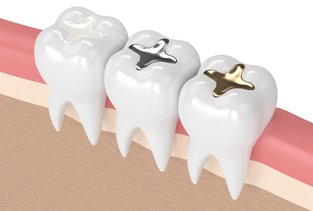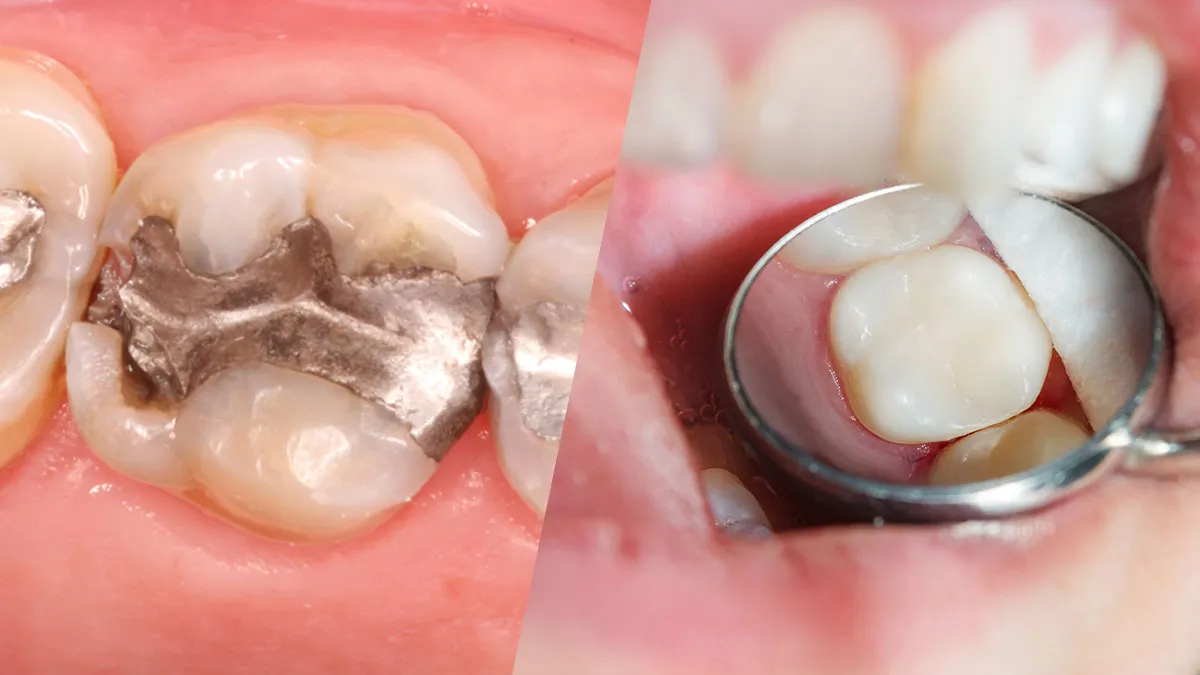
Comparing White Fillings vs. Amalgam: Finding the Right Choice
When it comes to dental fillings, there are two main options patients often consider: white fillings, also known as composite fillings, and amalgam fillings.
Both share the common purpose of restoring and safeguarding teeth, yet they differ in several aspects, including composition, appearance, strength, and durability.
Amalgam Vs Composite Fillings
White Fillings (Composite)
White fillings consist of a blend of resin and finely ground glass particles. This composite resin is not only strong, but also crafted to imitate the natural colour and translucency of teeth.
One of the primary benefits of white fillings is their capability to seamlessly blend with your natural teeth, rendering them almost imperceptible.
Amalgam Fillings
What is amalgam? In contrast, amalgam fillings are made up of a mixture of metals, including mercury, silver, tin, and copper. While they possess strength and have been employed in dentistry for over a century, their appearance substantially differs from that of natural teeth.
Amalgam fillings are silver in colour and can be conspicuous when you smile or open your mouth, which some patients may find less aesthetically pleasing.
When it comes to composition and visual aspect, white fillings undeniably hold the advantage. They provide a more aesthetically pleasing choice that effortlessly blends with your natural teeth.
Strength and Longevity
When assessing the strength and longevity of dental fillings, it's essential to contemplate the specific materials used and technological advancements.
White fillings have made significant strides in terms of longevity. While they may not be as robust as amalgam fillings, they still exhibit substantial durability and are well-suited for restoring teeth exposed to moderate to high stress loads. Recent innovations in composite materials have extended their lifespan, making them a dependable option for many patients.
Amalgam fillings are renowned for their strength and durability, making them an ideal choice for posterior teeth that endure more substantial biting forces. They can withstand the rigours of chewing and grinding better than white fillings.
Concerns About Toxicity
One of the primary apprehensions linked to amalgam fillings and what tooth fillings are made of is their mercury content.
Mercury is employed in amalgam fillings to amalgamate the other metals, but an ongoing debate regarding its safety persists. While most research indicates that amalgam fillings pose no harm to most individuals, certain people may express concerns about potential mercury exposure.
White fillings, conversely, are mercury-free and do not raise any toxicity concerns. This makes them a preferable choice for patients apprehensive about the presence of mercury in their dental work.
In terms of safety and toxicity, white fillings indisputably hold the upper hand over amalgam fillings.
Aesthetic Considerations
The visual impact of dental fillings, especially in noticeable regions of the mouth, holds significant importance for many patients. White fillings emerge as the clear victor in this category: their ability to harmonize with the natural colour of your teeth makes them an outstanding option for front teeth or any area where appearance takes precedence.
Amalgam fillings, owing to their silver hue, can be conspicuous when you smile or converse. This could be a concern for individuals who prioritize aesthetics and wish to keep their dental work discreet.
If appearance is a top priority for you, white fillings represent the obvious choice.
Application Procedure
The process of applying white fillings differs slightly from that of amalgam fillings.
For white fillings, the dentist will excise the decayed portion of the tooth, meticulously clean the area, and subsequently apply the composite resin material in successive layers. Each layer is solidified using a specialized light, and the dentist sculpts the filling to harmonize with the natural contours of your tooth. This procedure may consume more time than the placement of an amalgam filling due to the layering and curing steps involved.
Amalgam fillings are typically swifter to place. The dentist removes the decayed part of the tooth and then packs the amalgam material into the prepared space. Once the material solidifies, the best dental filling is shaped to fit the tooth's contours. The application procedure for amalgam fillings is straightforward and generally demands less chair time.

Suitability for Different Teeth
The decision between white fillings and amalgam may also hinge on which teeth necessitate restoration.
White fillings stand as an exceptional choice for front teeth and any teeth visible when you smile. They seamlessly blend with natural teeth and provide a more aesthetically pleasing outcome.
Amalgam fillings, with their superior strength, are better suited for posterior teeth, particularly molars. These teeth encounter more substantial biting forces and benefit from the added durability of amalgam.
It is crucial to confer with your dentist to ascertain which type of filling is your best dental filling. They can offer guidance grounded in your individual requirements.
Cost Considerations
Cost constitutes another vital factor when electing between white fillings and amalgam fillings.
White fillings tend to be pricier than amalgam fillings. The heightened cost is attributable to the materials used and the extra time necessary for the application process. Dental insurance may partially cover filling costs, but it is imperative to scrutinize your coverage and explore payment options with your dentist.
Amalgam fillings are generally more economical, making them an enticing option for those aiming to manage their dental expenditures effectively.
.jpeg)
Maintenance and Repairs
How long do white fillings last? Both white fillings and amalgam fillings require regular maintenance to ensure their continued effectiveness.
White fillings may necessitate replacement or repair over time, as they can become stained or chipped. Nevertheless, advancements in composite materials have bolstered their resilience, diminishing the need for recurrent repairs.
Amalgam fillings are distinguished for their durability and extended lifespan. They commonly endure for a more extended period without requiring repairs or replacement. Nevertheless, they can become discoloured over time, bestowing a grayish hue upon the teeth.
Ultimately, the choice of silver filling vs white fillings should be predicated on your unique inclinations, dental needs, and budget. Your dentist can provide you with tailored recommendations and facilitate an educated choice.
White Non-Metal Fillings at Skymark Smile Centre
At Skymark Smile Centre, we grasp the significance of a healthy and captivating smile. This is why we present white non-metal fillings as a contemporary and aesthetically pleasing solution for dental restorations.
Our accomplished dentists possess the expertise to furnish top-notch white fillings that blend effortlessly with your natural teeth, guaranteeing a smile you can take pride in.
The advantages of selecting white non-metal fillings at Skymark Smile Centre encompass:
Aesthetics: Our composite white fillings are meticulously designed to match the natural hue and translucency of your teeth, rendering them virtually invisible.
Durability: We employ advanced composite materials that exhibit both strength and prolonged lifespan.
Mercury-Free: Our white fillings are entirely devoid of mercury, allaying any concerns regarding toxicity.
Proficiency: Our team of dentists boasts considerable proficiency in cosmetic dentistry, ensuring outstanding results.
Individualized Attention: We invest time in comprehending your distinct prerequisites and fashioning tailored treatment strategies.
Whether you necessitate a filling for a front tooth or a posterior tooth, our adept team at Skymark Smile Centre can help you achieve the best permanent tooth filling out there for you.
Reach out to us today to book a consultation and discover more about our white non-metal safest fillings for teeth. Your journey toward best filling for teeth commences here.

